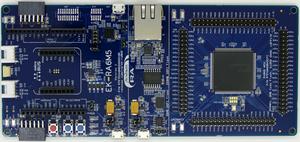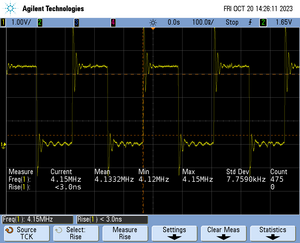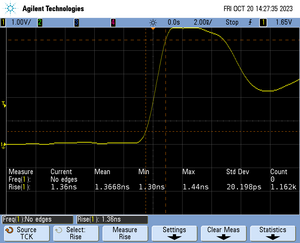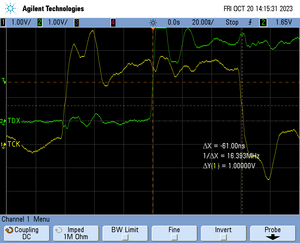Renesas RA6M5
The Renesas RA6M5 series are microcontrollers based on the ARM Cortex-M33 core.
Flash
Internal option-setting memory
Option-settings memory is located at 0x0100A100 has a size of 512 Bytes.
Internal program flash
The size of the program flash is dependent on the device used.
| Device | Size (KiB) | Memory region |
|---|---|---|
| R7FA6M5BF | 1024 | 0x00000000 - 0x000FFFFF |
| R7FA4M3AE | 1536 | 0x00000000 - 0x0017FFFF |
| R7FA6M5AH R7FA6M5BH |
2048 | 0x00000000 - 0x001FFFFF |
Currently only single bank flash operations are supported. Dual bank mode is not supported.
Internal data flash
Internal data flash is located at 0x08000000 has a size of 8 KB.
External QSPI flash
External QSPI flash is located at 0x60000000.
Supported pin configurations
QSPI flash programming requires special handling compared to internal flash. For more information about this, please see the QSPI Flash Programming Support article.
- CLK@P305_nCS@P306_D0@P307_D1@P503_D2@P104_D3@P505 (default)
- CLK@P500_nCS@P501_D0@P502_D1@P503_D2@P504_D3@P505
- CLK@P305_nCS@P306_D0@P307_D1@P308_D2@P309_D3@P310
Evaluation Boards
Tracing on RA6M5 series
Tracing on Renesas R7FA6M5
Minimum requirements
In order to use trace on the Renesas R7FA6M5 MCU devices, the following minimum requirements have to be met:
- J-Link software version V7.92h or later
- Ozone V3.30b or later (if streaming trace and / or the sample project from below shall be used)
- SEGGER Embedded Studio V7.30
- J-Trace PRO for Cortex-M HW version V3.0 or later for streaming trace
- J-Link Plus V12 or later for TMC/ETB trace
To rebuild the project our IDE Embedded Studio can be used. The recommended version to rebuild the projects is V6.30. But the examples are all prebuild and work out-of-the box with Ozone, so rebuilding is not necessary.
Streaming trace
The project has been tested with the minimum requirements mentioned above and a Renesas EK-RA6M5.
Example project: Renesas_R7FA6M5_TracePins.zip
Note: The example is shipped with a compiled .JLinkScriptfile, should you need the original source, please get in touch with SEGGER directly via our support system: https://www.segger.com/ticket/.
To create your own .JLinkScriptfile you can use the following guide as reference: How_to_configure_JLinkScript_files_to_enable_tracing
Trace buffer (TMC/ETB)
Example Project: Renesas_R7FA6M5_TraceBuffer.zip
Tested Hardware
Reference trace signal quality
The following pictures show oscilloscope measurements of trace signals output by the "Tested Hardware" using the example project. All measurements have been performed using a Agilent InfiniiVision DSO7034B 350 MHz 2GSa/s oscilloscope and 1156A 1.5 GHz Active Probes. If your trace signals look similar on your trace hardware, chances are good that tracing will work out-of-the-box using the example project. More information about correct trace timing can be found at the following website.
Trace clock signal quality
The trace clock signal quality shows multiple trace clock cycles on the tested hardware as reference.
Rise time
The rise time of a signal shows the time needed for a signal to rise from logical 0 to logical 1. For this the values at 10% and 90% of the expected voltage level get used as markers. The following picture shows such a measurement for the trace clock signal.
Setup time
The setup time shows the relative setup time between a trace data signal and trace clock. The measurement markers are set at 50% of the expected voltage level respectively. The following picture shows such a measurement for the trace data signal 0 relative to the trace clock signal.



